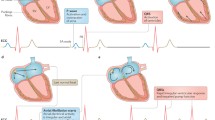Abstract
Atrial fibrillation is the most common sustained arrhythmia seen in clinical practice. In the Framingham study, the incidence is estimated to be 2% to 4% of the general population above 65 years of age [1]. The incidence is even higher in patients with underlying heart disease [2]. Atrial fibrillation may be associated with hemodynamic impairment, occasionally disabling symptoms, and a decrease in life expectancy. In advanced heart failure, atrial fibrillation is common and was found to be a marker for increased risk of death [3]. The most important concern with atrial fibrillation relates to its embolic manifestations that, in 75% of instances, result in cerebrovascular accidents [4, 5].
Access this chapter
Tax calculation will be finalised at checkout
Purchases are for personal use only
Preview
Unable to display preview. Download preview PDF.
Similar content being viewed by others
References
Kannel WB, Abbott RP, Savage DD, Mc Namara PM. Epidemiologic features of atrial fibrillation. The Framingham Study. N Engl J Med 1982; 306: 1018–22.
Kulbertus HE. Antiarrhythmic treatment of atrial arrhythmias. J Cardiovasc Pharm 1991; 17 (Suppl 6): S32–S5.
Middlekauff HR, Stevenson WG, Stevenson LW. Prognostic significance of atrial fibrillation in advanced heart failure. Circulation 1991; 84: 40–8.
Cabin HS, Clubb KS, Hall C, Perlutter RA, Feinstein AR. Risk for systemic embolization of atrial fibrillation without mitral stenosis. Am J Cardiol 1990; 61: 714–7.
Rawles J. Atrial Fibrillation. London: Springer-Verlag 1992: 181–97.
Coplen SE, Antman EM, Berlin JA, Hewitt P, Chalmers TC. Efficacy and safety of quini-dine therapy for maintenance of sinus rhythm after cardioversion. A meta-analysis of randomized control trials. Circulation 1990; 82: 1106–16.
Coumel P, Attuel P, Lavallée JP, Flammang D, Leclercq JF, Slama R. Syndrome d’arythmie auriculaire d’origine vagale. Arch Mal Coeur 1978; 71: 645–56.
Juul-Moller S, Edvardsson N, Rehnqvist-Ahlberg N. Sotalol versus quinidine for the maintenance of sinus rhythm after direct current conversion of atrial fibrillation. Circulation 1990; 82: 1932–9.
Crijns HJGM. Drugs after cardioversion to prevent relapses of chronic atrial fibrillation or flutter. In Kingma JH et al. (eds): Atrial fibrillation, a treatable disease? Dordrecht: Kluwer Academic Publishers 1992; 105–48.
Reimold SC, Cantillon CO, Friedman PL et al. Propafenone versus Sotalol for suppression of recurrent symptomatic atrial fibrillation. Am J Cardiol 1993; 71: 558.
Antiarrhythmic therapy: A pathophysiologic approach. Members of the Sicilian Gambit (eds). Armonk, NY: Futura Publishing Co., Inc. 1994.
Lévy S, Novella P, Ricard Ph, Paganelli F. Paroxysmal atrial fibrillation: A need for classification. J Cardiovasc Electrophysiol 1995; 6: 69–74.
Anderson JL, Gilbert EM, Alpert BL et al. Prevention of symptomatic recurrences of paroxysmal atrial fibrillation in patients initially tolerating antiarrhythmic therapy. Circulation 1989; 80: 1557–70.
Antman EM, Beamer AD, Cautillon C et al. Therapy of symptomatic atrial fibrillation and atrial flutter: A staged care approach with new antiarrhythmic drugs. J Am Coll Cardiol 1990; 15: 698.
Coplen SE, Antman EM, Berlin JA, Hewitt P, Chalmers TC. Efficacy and safety of quinidine therapy for maintenance of sinus rhythm after cardioversion. A meta-analysis of randomized control trials. Circulation 1990; 82: 1106–16.
Flaker GC, Blackshear JL, McBride R et al. Antiarrhythmic drug therapy and cardiac mortality in atrial fibrillation. J Am Coll Cardiol 1992; 20: 527–32.
Lévy S, Lauribe Ph, Dolla E et al. A randomized comparison of external and internal cardioversion of chronic atrial fibrillation. Circulation 1992; 86: 1415–20.
Lundstrom T, Ryden L. Ventricular rate control and exercise performance in chronic atrial fibrillation: effects of diltiazem and verapamil. J Am Coll Cardiol 1990; 16: 86–90.
Feld GK. Atrial fibrillation: Is there a safe and highly effective pharmacological treatment: Circulation 1990; 82: 2248–50.
Editor information
Editors and Affiliations
Rights and permissions
Copyright information
© 1996 Kluwer Academic Publishers
About this chapter
Cite this chapter
Lévy, S. (1996). Atrial fibrillation: maintaining the sinus rhythm. In: Oto, M.A. (eds) Practice and Progress in Cardiac Pacing and Electrophysiology. Developments in Cardiovascular Medicine, vol 183. Springer, Dordrecht. https://doi.org/10.1007/978-94-009-0219-0_5
Download citation
DOI: https://doi.org/10.1007/978-94-009-0219-0_5
Publisher Name: Springer, Dordrecht
Print ISBN: 978-94-010-6582-5
Online ISBN: 978-94-009-0219-0
eBook Packages: Springer Book Archive



